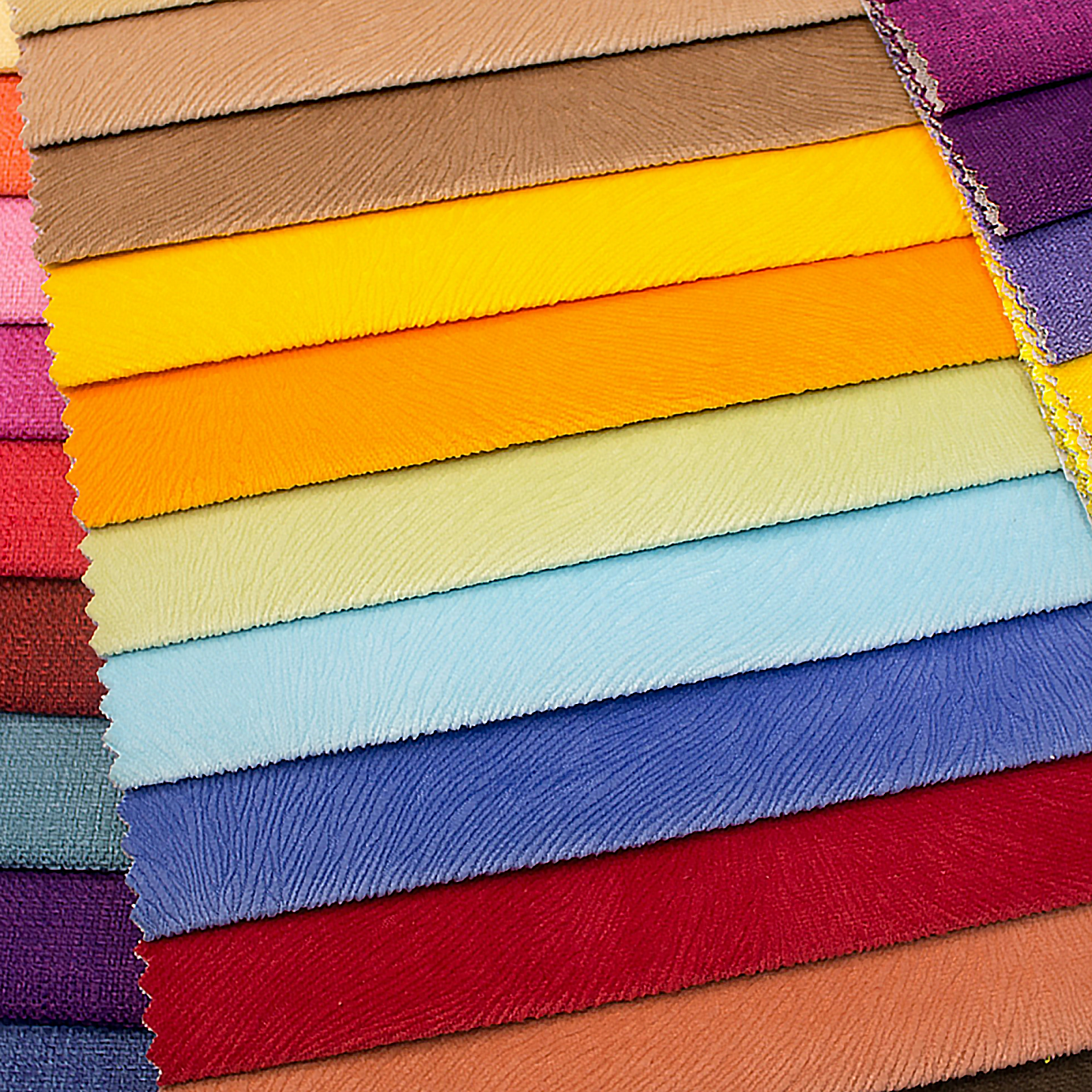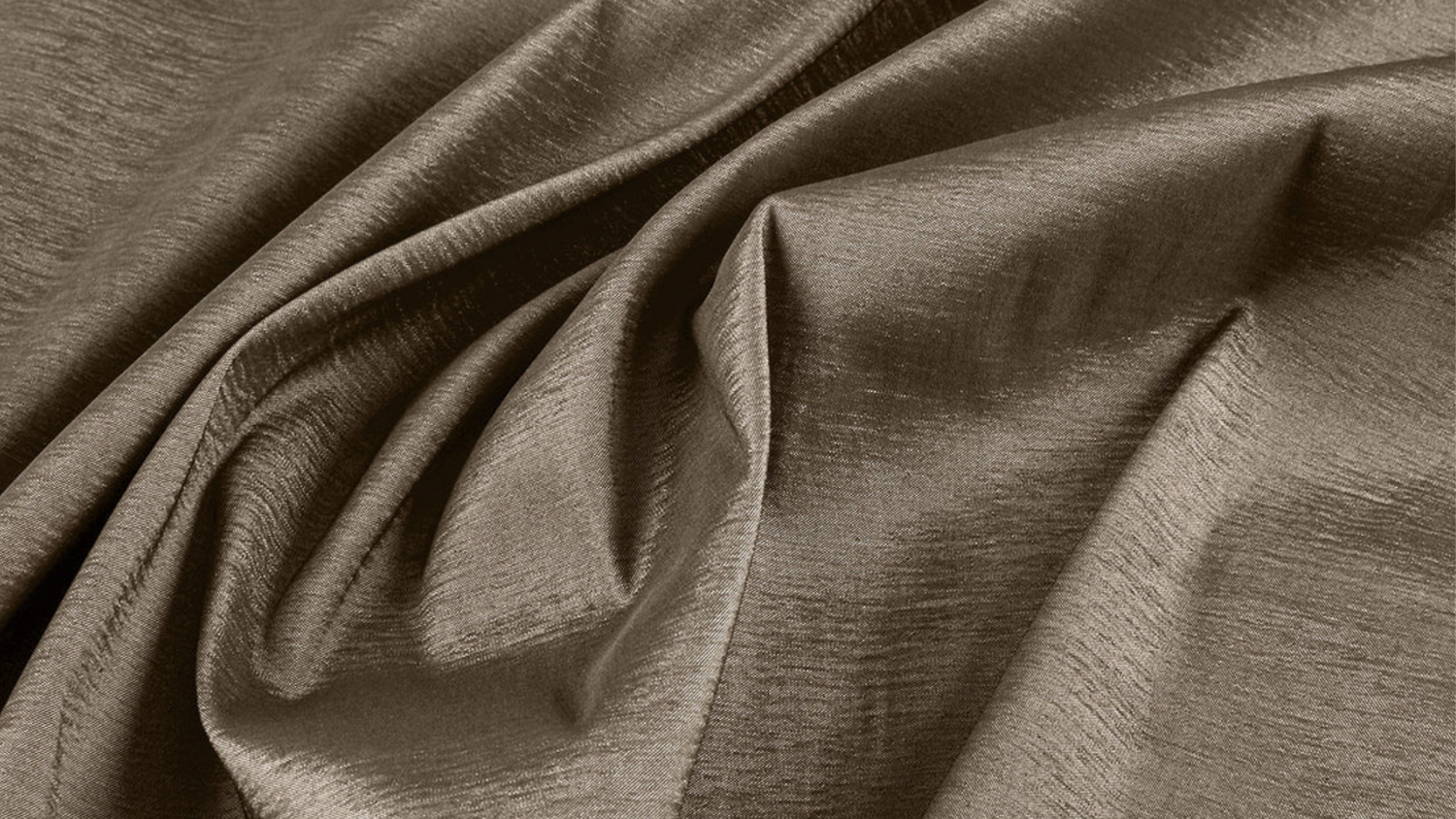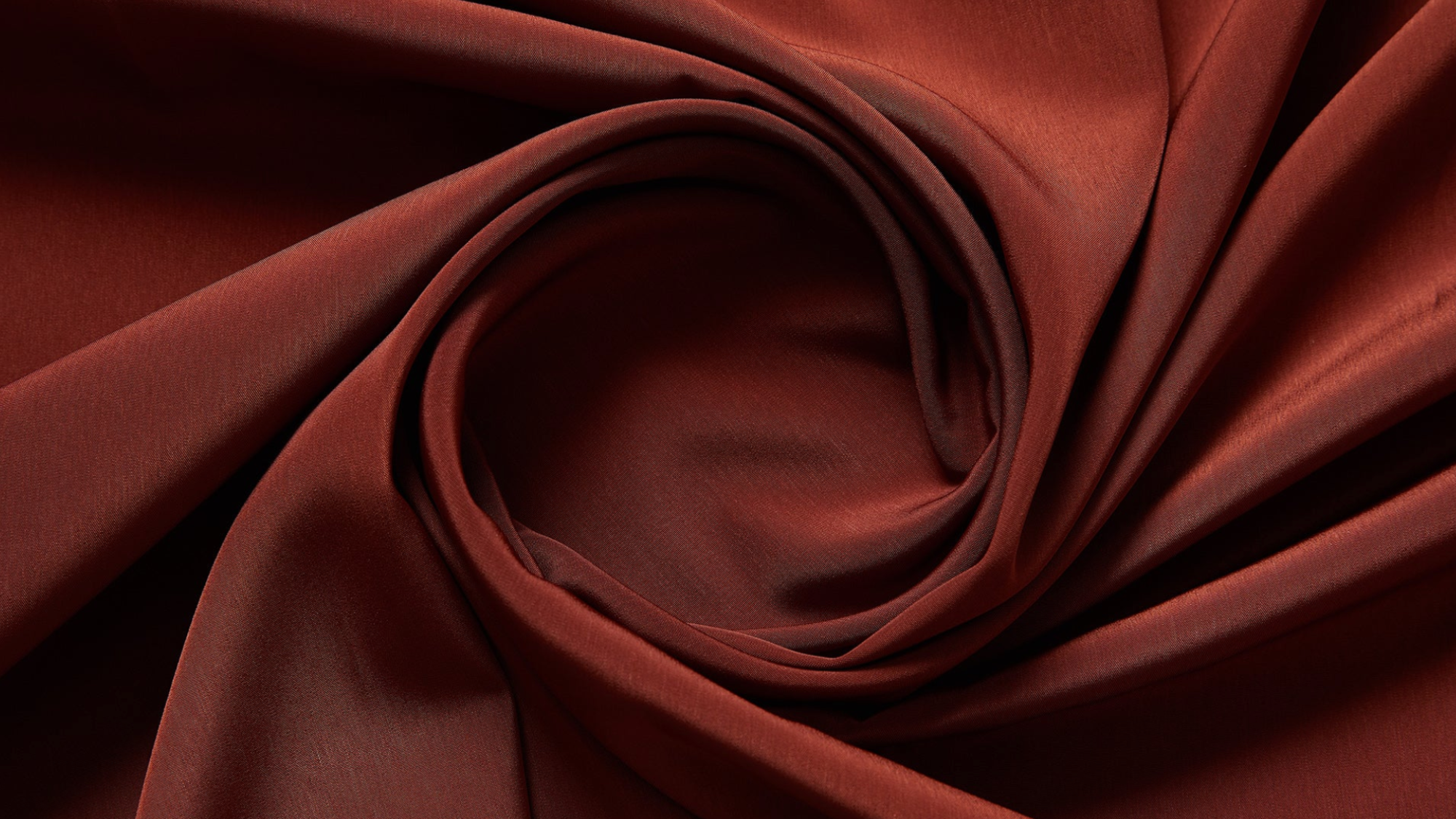
Known for its luxurious texture and iconic shine, taffeta fabric is as multifaceted as they come. For care tips and sewing best practices, read more in the Zelouf guide to taffeta fabric.
What is taffeta fabric?
Taffeta is a type of fabric known for its luxurious and smooth texture. It is characterized by a fine, tightly woven weave and a glossy surface that can create a shimmering effect. Taffeta fabric is typically made from various fibers, including silk, acetate, polyester, and nylon. Silk taffeta fabric is the most well-known and prestigious type, prized for its natural sheen and high-quality feel.
Key characteristics of taffeta fabric include:
- Smooth Surface: Taffeta has a very smooth and shiny surface, which makes it highly reflective and gives it a luxurious appearance.
- Crinkling Sound: When touched or moved, taffeta can produce a distinctive rustling or crinkling sound due to its crisp nature.
- Stiffness: Taffeta is often a stiffer fabric than other textiles, which can be advantageous for structured garments and formal wear.
- Versatility: Taffeta is used in various applications, including evening gowns, wedding dresses, formal wear, and decorative elements like curtains, drapes, and ribbons.
- Color Vibrancy: Taffeta fabric is known for its ability to hold vibrant and rich colors, which adds to its appeal in the fashion and design industries.
Taffeta is a popular choice for special occasions and formal wear due to its elegant appearance. However, its stiffness and ability to wrinkle easily may make it less suitable for casual or everyday clothing. When sewing with taffeta, it's essential to be mindful of its unique characteristics, such as its crispness and susceptibility to wrinkles, to achieve the desired results. Additionally, proper care is necessary to maintain the fabric's sheen and quality over time.

Zelouf Ariel Stretch Taffeta in Lagoon Frost
When did taffeta fabric become popular?
Taffeta fabric has a long history and has been popular for several centuries. Its popularity can be traced back to its introduction in the Middle East during the medieval period. Taffeta, originally made of silk, was highly sought after for its luxurious sheen and was often associated with nobility and royalty due to its expense and exclusivity.
Here's a brief overview of the popularity of taffeta fabric in different historical periods:
- Medieval and Renaissance Periods: Taffeta became popular in the Middle East and was introduced to Europe during the medieval and Renaissance periods. It was highly valued for its glossy surface and was used for making elaborate garments for the upper classes.
- 17th and 18th Centuries: Taffeta continued to be popular during Europe's Baroque and Rococo eras. It was used for creating opulent gowns and court attire, particularly in France and England.
- 19th Century: Taffeta remained a favored fabric for women's fashion in the 19th century, especially for formal dresses, ball gowns, and wedding attire.
- 20th Century: Taffeta continued to be used in the fashion industry and became popular for cocktail dresses, evening gowns, and wedding dresses. In the mid-20th century, synthetic versions of taffeta, such as acetate and polyester taffeta, were developed, making the fabric more affordable and accessible.
- Contemporary Times: Taffeta remains a staple in the fashion world, especially for formalwear and bridal gowns. It is also used in various decorative and upholstery applications.
Taffeta's popularity has endured over the centuries due to its elegant appearance, rich colors, and unique sheen. While it has evolved with the introduction of synthetic variants, silk taffeta continues to be associated with luxury and special occasions.
 Zelouf Jessica Taffeta in Peony Spritz
Zelouf Jessica Taffeta in Peony Spritz
Is taffeta fabric outdated?
Taffeta fabric is not outdated; rather, it is a classic and timeless material that continues to be used in various fashion and design applications. While fashion trends evolve, taffeta has a lasting appeal due to its elegant and luxurious characteristics. Here are a few reasons why taffeta is still relevant:
- Classic Elegance: Taffeta's smooth texture and natural sheen give it a timeless and elegant look that makes it suitable for special occasions, formal events, and classic designs.
- Versatility: Taffeta is adaptable to contemporary fashion trends. Designers and stylists often incorporate taffeta into their collections for a touch of sophistication, and it remains popular for evening gowns, bridal wear, and formal attire.
- Variety of Options: Taffeta is available in various colors and finishes, allowing designers and consumers to create a wide range of looks, from classic to modern.
- Decorative Use: Taffeta is not limited to clothing; it is also used in interior design for drapes, curtains, and upholstery. Its vibrant colors and sheen can add a touch of luxury to home decor.
- Blend of Tradition and Modernity: Taffeta can be used to combine traditional elegance with modern styling, ensuring it remains a relevant choice in the world of fashion and design.
While taffeta may not be as prevalent in everyday casual wear, it is still in demand for special events, red-carpet appearances, and formal occasions. Its enduring appeal and timeless qualities make it a valuable option for those looking to add a touch of classic sophistication to their wardrobe or interior decor.

Zelouf Solid Poly Taffeta in Hot Fuscia
Tips for sewing taffeta fabric
Sewing with taffeta fabric can be a rewarding but somewhat challenging experience due to its unique characteristics. Here are some tips for sewing taffeta fabric successfully:
- Use the Right Needles: Use sharp, fine sewing machine needles designed for lightweight fabrics. A universal or microtex needle will work well for taffeta. Be sure your needle is sharp to prevent snagging the delicate fibers.
- Pin with Care: Taffeta is prone to snags and pinholes. Use fine pins to pin within the seam allowances to avoid visible holes. Alternatively, consider using fabric clips or hand-basting to hold the fabric together.
- Cut with Precision: Use sharp fabric scissors or a rotary cutter to cut taffeta. Cut with clean, smooth strokes to prevent fraying and ensure straight edges.
- Match Stripes and Patterns: If your taffeta has stripes or patterns, take extra care to match them perfectly at the seams. This requires precise cutting and pinning.
- Press with Caution: Taffeta is sensitive to heat, so be careful when pressing. Use a low to medium heat setting on your iron and place a pressing cloth (such as a clean cotton fabric) between the iron and the taffeta to prevent shine or heat damage.
- Sew Slowly: Taffeta tends to shift while sewing, so sew slowly and use a walking foot or a fine, even feed foot attachment to help guide the fabric evenly. Maintain a consistent, light tension on the fabric.
- Backstitch Lightly: When backstitching to secure your seams, do so gently to avoid creating pronounced knots on the right side of the fabric.
- Reduce Thread Tension: Taffeta is a delicate fabric, and too much tension can cause puckering or pulling. Lower the thread tension slightly to achieve smoother, even stitches.
- Use a Quality Thread: Choose a high-quality, fine thread that matches the color of your taffeta. This will help prevent visible seams and ensure a professional finish.
- Finish Seams: Consider finishing the raw edges of your taffeta fabric with methods like French seams, serging, or using pinking shears to prevent fraying.
- Practice on a Scrap: If you're new to sewing taffeta, it's a good idea to practice on a scrap piece of the same fabric to get a feel for how it behaves with your specific sewing machine.
- Handle with Clean Hands: Taffeta is prone to showing oil and dirt marks. Always handle it with clean hands to avoid stains.
Remember that taffeta can be delicate, but with patience and the right techniques, you can create beautiful, professional-looking garments and projects with this elegant fabric.

Zelouf Crushed Stretch Taffeta in Champagne
How to care for taffeta fabric
Taffeta fabric is often labeled as "dry clean only" due to its delicate nature and sensitivity to water and heat. However, there are some care tips you can follow to maintain and clean taffeta fabric without the need for frequent dry cleaning:
- Spot Cleaning: You can perform spot cleaning for small stains or spills. Blot the stained area gently with a clean, white cloth or a cotton ball dipped in cold water. Avoid rubbing, as it can damage the fabric.
- Test a Hidden Area: Before attempting any cleaning method, test it on a small, inconspicuous area of the taffeta to ensure it doesn't damage the fabric or change the color.
- Use a Mild Detergent: If you must wash taffeta, use a gentle, mild detergent specifically designed for delicate fabrics. Dilute it in cold water and handwash the garment in a basin or sink.
- Gentle Hand Washing: Fill a basin or sink with cold water and add a small amount of mild detergent. Submerge the taffeta garment and agitate the water gently by hand. Do not twist or wring the fabric.
- Rinse Thoroughly: Rinse the taffeta garment in cold water until all detergent is removed. Again, be gentle and avoid wringing.
- Lay Flat to Dry: Lay the taffeta garment flat on a clean, dry towel or on a clean, white cloth to air dry. Avoid hanging it, as the weight of the water can stretch and distort the fabric.
- Keep It Cool: Always use cold water for washing and rinsing taffeta, as hot water can cause the fabric to shrink and lose its sheen.
- Avoid Direct Sunlight: When drying taffeta, keep it out of direct sunlight to prevent fading or damage to the fabric.
- Store Carefully: When not in use, store taffeta garments in a cool, dry place away from direct sunlight. Use padded hangers to avoid creating creases, and consider placing tissue paper between layers to prevent wrinkles.
- Steam with Caution: If your taffeta garment becomes wrinkled, use a handheld steamer on the lowest setting to gently remove wrinkles. Keep the steamer at a distance from the fabric to avoid heat damage.
While these care tips may help you maintain taffeta fabric without frequent dry cleaning, it's essential to consult the care label on your specific taffeta garment for manufacturer-recommended care instructions. In some cases, dry cleaning may still be the safest option for preserving the fabric's appearance and integrity.
Where can I buy taffeta fabric?
At Zelouf Fabrics, we have hundreds of varieties of taffeta fabric, available wholesale or by the yard. Explore the glamorous possibilities in our taffeta collection.




